#ca. 1899-1901
Text

Art Nouveau Pendant
René Lalique
ca. 1899-1901
648 notes
·
View notes
Text
La Morte

The sick child, 1896 | Edvard Munch (1863-1944, Norway)

Funerale bianco (White funeral), 1901 | Edoardo Berta (1867-1931)

Autoritratto macabro (macabre self-portrait), 1899 | Carlo Fornara (1871-1968, Italia)

Tombe romane (roman tombs), Concordia (Venice), 1887 | Filippo Franzoni (1857-1911, Switzerland)
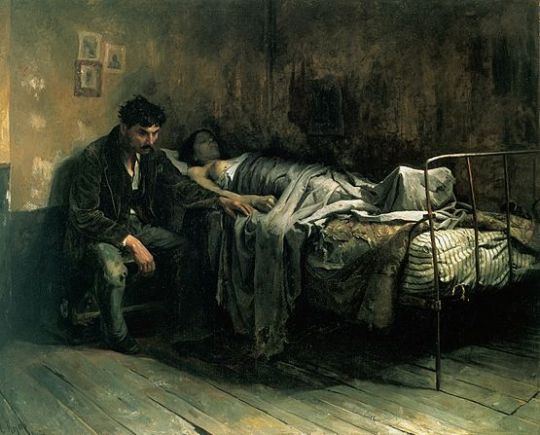
Miseria, 1886 | Cristóbal Rojas (1857-1890, Venezuela)

Böcklin's grave, 1901-02 (Staatliche Kunsthalle, Karlsruhe) | Ferdinand Keller (1876-1958, Germany)

The widow (detail), 1882-83 | Anders Zorn (1860-1920, Sweden)

L’adultera o La femme de Claude, 1877 (Galleria d’Arte Moderna, Torino) | Francesco Mosso (1848-1877, Italia)

The funeral of Shelley, 1889 | Louis Édouard Fournier (1857-1917, France)

La peine de mort | Félicien Rops (1833-1898, Belgium)

Funeral at sea (on the death of the painter David Wilkie), 1842 (Tate Gallery, London) | William Turner (1775-1851, England)

La mort de Marat, 1793 (Musées royaux des Beaux-Arts, Bruxelles) | Jacques-Louis David (1748-1825, France)
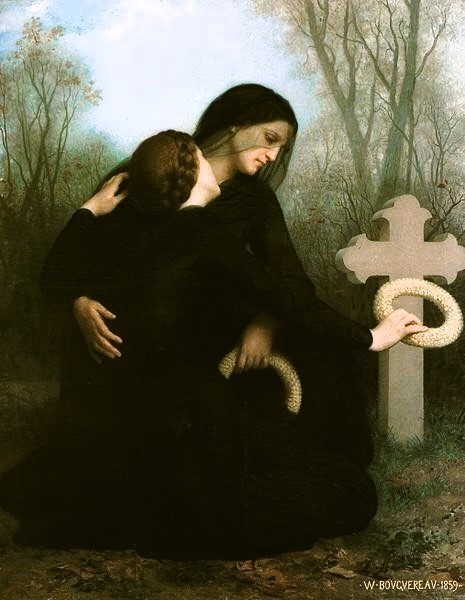
Le jour des morts, 1859 (Musée des Beaux-Arts, Bordeaux) | William Adolphe Bouguereau (1825-1905, France)

Death on the pale horse, 1865 | Gustave Doré (1832-1883, France)

Il trionfo della morte, 1464 ca. (Palazzo Abatellis, Palermo) | Anonimo

Roman widow | Dante Gabriel Rossetti (1828-1882, England)

Cemetery in the moonlight, 1822 | Carl Gustav Carus (1789-1869, Germany)

The plague, 1898 | Arnold Böcklin (1827-1901, Switzerland)

Ophelia, 1851-52 (Tate Britain, London) | John Everett Millais (1829-1996, England)
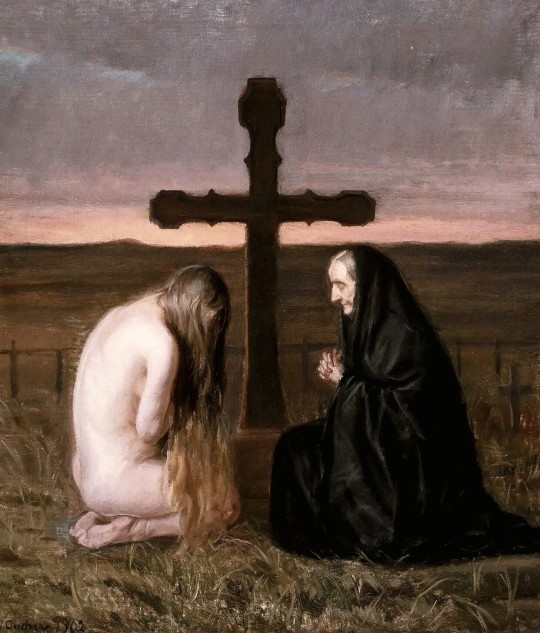
Grief, 1902 | Anna Ancher (1859-1935, Denmark)

The plague of pestilence, portfolio (two of seven etchings), 1920 | Stefan Eggeler (1894-1969, Austria)
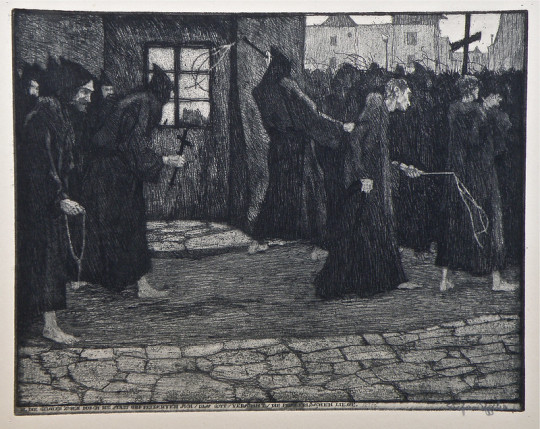
The plague of pestilence, portfolio (three of seven etchings), 1920 | Stefan Eggeler (1894-1969, Austria)

Dr. Nicolaes Tulp's anatomy lesson, 1632 | Rembrandt (1606-1669, Netherlands)

La sepoltura del conte di Orgaz (El Entierro del conde de Orgaz), 1586 (Chiesa di Santo Tomé, Toledo) | El Greco (1541-1614, Greece)

Woman on her deathbed, 1883 (Kröller-Müller Museum, Otterlo) | Vincent van Gogh (1853-1890, Netherlands)

Princess Tarakanova, in the Peter and Paul Fortress at the time of the flood, 1864 | Konstantin Flavitsky (1830-1866, Russia)
2 notes
·
View notes
Text

Mary Morgan Keipp, The Grape-Vine Swing, ca. 1900-1904, platinum print, sheet and image: 8 1⁄4 x 6 1⁄4 in. (21.0 x 15.9 cm.), Smithsonian American Art Museum, Museum purchase from the Charles Isaacs Collection made possible in part by the Luisita L. and Franz H. Denghausen Endowment, 1994.91.218
Mary Morgan Keipp ( #bornonthisday October 25, 1875 in Selma, Alabama – 1961 in Selma, Alabama) was a noted figure in the art photography movement of the early 20th century, exhibiting her photographs of rural Dallas County African-Americans in major exhibitions at the New York Camera Club (December 1899), the Annual Photographic Salon (November 1900), Dudley Galleries in London (October 1901), and the National Arts Club of New York Photo-Secession Exhibition (1902). Via Wikipedia
0 notes
Text
Milano: apre al pubblico la mostra Leonardo Bistolfi, simbolista visionario.
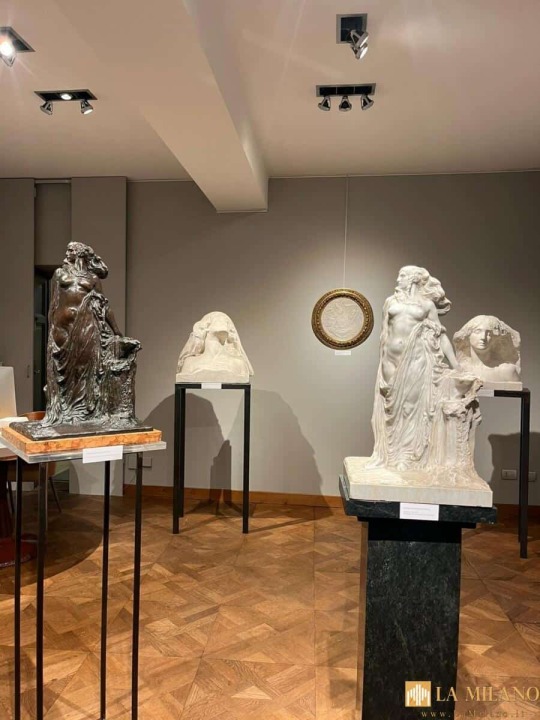
Milano: apre al pubblico la mostra Leonardo Bistolfi, simbolista visionario.
Da domani 20 ottobre Galleria Silva accoglierà una scelta delle più affascinanti e visionarie opere di uno dei maggiori protagonisti del simbolismo europeo: Leonardo Bistolfi (Casale Monferrato, 15 marzo 1859 – La Loggia, 3 settembre 1933). La mostra sarà una ricognizione all'interno dell'affascinante e visionario universo espressivo dello scultore piemontese, il cui personalissimo e altamente immaginoso linguaggio plastico ebbe non poche ripercussioni stilistiche tanto in Europa quanto oltreoceano, arrivando a influenzare la coeva statuaria monumentale dell'America centromeridionale (infatti già all'epoca la critica parlava di "bistolfismo" e di scultori "bistolfiani").
Formatosi prima all'Accademia di Brera a Milano e poi all'Albertina di Torino, sotto la guida di Odoardo Tabacchi, dopo un esordio di matrice verista e scapigliata, Bistolfi aprì i propri orizzonti estetico-culturali al simbolismo letterario di matrice franco-fiamminga e alle istanze del decadentismo europeo. Egli si identificava in modo particolare nel concetto di "operaio della Bellezza", seguendo una linea ideologica e spirituale che era, in sostanza, quella tracciata da John Ruskin e William Morris.
Opere in mostra
Proprio al periodo simbolista, il più rappresentativo e influente della sua intensa carriera, è dedicata l'esposizione di Galleria Silva: un percorso ideale che va da una versione in gesso della testa dell'Alpe per il Monumento a Giovanni Segantini di Saint-Moritz (La Bellezza liberata dalla Materia, 1899-1906), forse la scultura più iconica dell'intera produzione bistolfiana, per approdare al marmo La Volontà o L'Industria (1925 ca.), uno straordinario esemplare proveniente dalla collezione storica di un illustre personaggio, legato a Bistolfi da un antico vincolo amicale, e da essa mai uscito fino a oggi. La Volontà rappresenta al massimo grado la parziale mutazione dei moduli simbolisti dell'autore, avvenuta dopo la Grande Guerra e durante i primi anni del ventennio littorio, per cui il turgore delle forme e la monumentalità della figura allegorica tradiscono un timbro diverso, più carico e sensuoso, in un certo senso più "novecentista", rivelando una sontuosità e un'opulenza visibilmente accentuate.
Completano il percorso un esemplare di misure ridotte della Croce Brayda (1901), assai rara da trovarsi in terracotta; la targa per la Società Bibliografica di Torino (1905-1906), prezioso gesso carico di echi preraffaelliti, dedicato all'amico scultore, pittore e scenografo Lodovico Pogliaghi; il particolare in bronzo della figura femminile di destra della targa per la Cassa di Risparmio di Milano (1906), uno dei testi figurativi di Bistolfi maggiormente compromessi con il Liberty, sull'onda lunga dell'Esposizione internazionale d'arte decorativa moderna di Torino del 1902, per la quale l'artista aveva disegnato un celebre manifesto; l'ispiratissima targa funeraria per André Gladès (1906-1908 ca.), pseudonimo maschile della scrittrice svizzera Nancy-Marie Vuille, morta trentanovenne a Ginevra nel gennaio 1906; il bassorilievo in gesso della Culla per il monumento-ossario La Patria (1906), commemorativo della battaglia del 1706 a Madonna di Campagna; il gesso del verso del modello della medaglia per le gare sportive "Florio" di Palermo (1907); e, sempre in gesso, la testa della figura della Morte del monumento funerario Abegg (1912-1913), collocato nel cimitero di Zurigo. Non va infine dimenticata la targa in bronzo per Giovanni Faldella e Leonardo Bistolfi (1913), cavalieri dell'ordine civile di Savoia, significativa opera "bistolfiana" del torinese Edoardo Rubino. In mostra sarà presente un catalogo a cura di Armando Audoli....
#notizie #news #breakingnews #cronaca #politica #eventi #sport #moda
Read the full article
0 notes
Text
About Pablo Picasso

Pablo Picasso (1881 - 1973) was undoubtedly the most famous artist of the twentieth century. During his artistic career, which lasted more than 75 years, he created thousand of works using all kind materials, parenting, sculptures, prints, and ceramics. He almost single-handedly created modern art. Picasso pioneered virtually every revolution in European art and fathered American abstract art, which discarded its reliance on subject matter but which is based on his techniques and forms. He changed art more profoundly than any other artist of this century. First famous for his pioneering role in Cubism, Picasso continued to develop his art with a pace and vitality comparable to the accelerated technological and cultural changes of the twentieth century. Each change embodied a radical new idea, and it might be said that Picasso lived several artistic lifetimes.
Picasso's styles are so diverse that they change not only from decade to decade but from day to day. His creative mentality enables him to creat a soothing mother and child in a monumental classical style bathed in pastels, as well as twisting, crudely angular, multifaceted and stridently colored female who is torturously complex. The inspiration for both paintings in the same woman. To Picasso this is not an anomaly, for he sees that every living person is a combination of opposing forces.
He has said the is belief is in existing itself, which gives him a limitless setting from which to draw his ideas. He does not understand beauty in concepts of a setting sun over lush fields ready for harvest or sophisticated personages sitting in splendid elegance. His curiosity, hence, his art, includes the most commonplace as well as the most spectacular and marvelous manifestations of life.
To use Picasso's often quote words: "I paint not what I see, I paint what I know." His greatness lies in his ability to formalize his finding into comprehensible visual terms.
Pablo Picasso was born on October 25, 1881, in Málaga, Spain. The son of an academic painter, José Ruiz Blasco, he began to draw at an early age. In 1895 the family moved to Barcelona, and Picasso studied there at La Lonja, the academy of fine arts. His visit to Horta de Ebro from 1898 to 1899 and his association with the group at the café Els Quatre Gats in about 1899 were crucial to his early artistic development. Picasso’s first exhibition took place in Barcelona in 1900, and that fall he went to Paris for the first of several stays during the early years of the century. Picasso settled in Paris in April 1904, and his circle of friends soon included Guillaume Apollinaire, Max Jacob, Gertrude and Leo Stein, as well as two dealers, Ambroise Vollard and Berthe Weill.
His style developed from the Blue Period (1901–04) to the Rose Period (1905) to the pivotal work Les Demoiselles d’Avignon (1907), and the subsequent evolution of Cubism from an Analytic phase (ca. 1908–11) to its Synthetic phase (beginning in 1912–13). Picasso’s collaboration on ballet and theatrical productions began in 1916. Soon thereafter, his work was characterized by neoclassicism and a renewed interest in drawing and figural representation. In the 1920s the artist and his wife, Olga (whom he had married in 1918), continued to live in Paris, to travel frequently, and to spend their summers at the beach. From 1925 to the 1930s Picasso was involved to a certain degree with the Surrealists, and from the fall of 1931 he was especially interested in making sculpture. In 1932, with large exhibitions at the Galeries Georges Petit, Paris, and the Kunsthaus Zürich, and the publication of the first volume of Christian Zervos’s catalogue raisonné, Picasso’s fame increased markedly.
By 1936 the Spanish Civil War had profoundly affected Picasso, the expression of which culminated in his painting Guernica (1937, Museo Nacional Centro de Arte Reina Sofía, Madrid). Picasso’s association with the Communist Party began in 1944. From the late 1940s he lived in the south of France. Among the enormous number of exhibitions that were held during the artist’s lifetime, those at the Museum of Modern Art, New York, in 1939 and the Musée des Arts Décoratifs, Paris, in 1955 were most significant. In 1961 the artist married Jacqueline Roque, and they moved to Mougins. There Picasso continued his prolific work in painting, drawing, prints, ceramics, and sculpture until his death on April 8, 1973.
0 notes
Photo

Interior by Sir William Orpen, ca. 1901
Even though we know who they are, the couple posing in William Orpen’s Interior are not sitting for a double portrait. The man, his eyes downcast, leans on a cabinet, while the woman, seated beside him looks away. In the dingy room the conversation has subsided. Their placing, and the momentary lapse that links them, suggests that complex events, those of a play, or a novel, have brought them to this point. The painter had, as we know from his success with The Play Scene from ‘Hamlet’, 1899 (Private Collection), an unerring sense of theatre.
The present picture is one from an exceptional series of interiors begun at 21 Fitzroy Street, London, in 1899-1901. The group includes, A Mere Fracture, The Valuers, The Chess-Players, The Refugees, A Window London Street, and the present work. While in a number of instances these works followed the artist to his new rooms in Honiton Street, Chelsea following his marriage to Grace Knewstub in August 1901, Interior appears to have been abandoned around the time of the move. Before his wedding, the young artist remained in close contact with former Slade School friends who gathered at the gaunt eighteenth-century terrace, then known as The Newcomes, and so named because it was the former abode of Colonel Newcome and his artist son, Clive, the eponymous heroes of William Makepeace Thackeray’s novel (1855). (In Thackeray’s day the area around Fitzroy Square was known as ‘Anglo-India’ on account of its popularity with retired colonial service officers, of which the fictional Colonel Newcome was one.)
By 1899, when Orpen left the Slade School of Fine Art, the house was in the hands of Augusta Everett, the eccentric mother of John (Herbert) Everett, one of his Slade contemporaries (see Gwen Yarker, Inquisitive Eyes, Slade Painters in Edwardian Wessex, 2016, Sansom & Co, Bristol, pp. 43-55.) Orpen occupied rooms in the cellar, installed a four-poster bed which features in The English Nude (Mildura Art Centre) and the portrait of Augustus John (National Portrait Gallery, London), and, when potential sitters appeared, sprinkled eau-de-Cologne to kill the smells that rose from the earthen floor. Here, under the rafters of the dreary edifice, he also worked on Interior.
The painting shows Emily Elizabeth Scoble, the artist’s model and girlfriend prior to his marriage. Not only was she The English Nude, but she also posed for The Mirror (Tate, London), shown at the New English Art Club winter exhibition in 1900, and one of the artist’s most celebrated works. Behind her stands Everard Meynell, also a Slade student and son of Alice Meynell, Oscar Wilde’s ‘Sybil of Style’, and one of the most respected late Victorian women poets. His father Wilfrid, an important editor and publisher, patronised Orpen around 1900 and wrote the early article on the painter. (Wilfrid Meynell, ‘William Orpen’, The Artist, vol XXXI, no 260, August 1901, pp. 177-185. Wilfrid, for instance, purchased Orpen’s Portrait of Augustus John, 1900, which his daughter, Olivia, sold to the National Portrait Gallery in 1948 for £400).
5 notes
·
View notes
Text
“VIOLENCE WILL NOT BRING CHANGE.”
That’s what Biden said in his latest advert.
Are we kidding ourselves here? Seriously? It’s the AMERICAN WAY! Let’s review a little history...

1619: SLAVERY BEGINS in AMERICA
American Revolutionary War (1775–1783)
Cherokee–American wars (1776–1795) USA v. Native Americans
Northwest Indian War (1785–1793) USA v. Native Americans
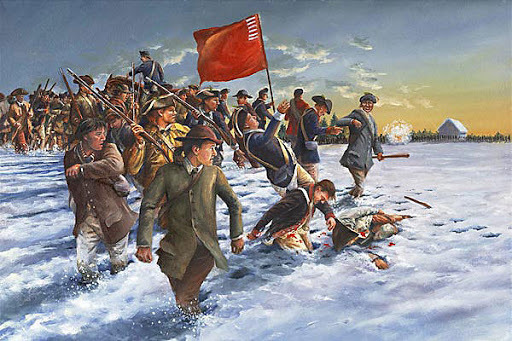
Shays' Rebellion (1786–1787) USA v. Citizens During Debt Crisis
Whiskey Rebellion (1791–1794) USA v. Citizens over TAXES
Quasi-War (1798–1800) Naval Pissing Match- USA v. France
Fries Rebellion (1799–1800) USA . PA Dutch Farmers over TAXES
First Barbary War (1801–1805) USA & Sweden v. N. Africa (Pirates)
German Coast Uprising (1811) Slave Rebellion in New Orleans v. USA
Tecumseh's War (1811) Native Annihilation.
War of 1812 (1812–1815) USA v. Britain over UK’s seizure of ships and men
Creek War (1813–1814) USA v. Alabama Native Americans
Second Barbary War (1815) Again.
First Seminole War (1817–1818) USA v. Florida Native Americans
Texas–Indian Wars (1820–1875) USA v. Texas Natives & Spain/Mexico
Arikara War (1823) USA v. Sioux Native Americans
Aegean Sea Anti-Piracy Operations of the United States (1825–1828)
Winnebago War (1827) USA v. Wisconsin Native Americans
First Sumatran expedition (1832) USA v. Indonesia
Black Hawk War (1832) USA v. Ill & Mich Native Americans
Texas Revolution (1835–1836) USA v. Mexico to steal Tex-ass
Second Seminole War (1835–1842) USA v. Native Americans in Florida
Second Sumatran expedition (1838)
Aroostook War (1838) USA v. Britain over N. Brunswick & Maine Border
Ivory Coast expedition (1842) USA v. Bereby, W. Africa against Slavers
Mexican–American War (1846–1848) USA v. Mexico to seize TX, NM & CA
Cayuse War (1847–1855) USA v. Oregon Native Americans (Annihilation)
Apache Wars (1851–1900) USA v. Apache Native Americans in s.west

Bleeding Kansas (1854–1861) USA v. USA Kansas & Missouri Conservative PRO-Slavery versus Abolitionist/Progressive ANTI-Slavery in new territories.
Puget Sound War (1855–1856) USA v. coastal Wash. State Native Americans
First Fiji expedition (1855) USA v. Fiji over the islanders not wanting rich American fucks there anymore. We did away with that by force, by Harry!
Rogue River Wars (1855–1856) USA v. Oregon Native Americans
Third Seminole War (1855–1858) USA purges last of Florida Natives
Yakima War (1855–1858) USA v. Washington Native Americans
Second Opium War (1856–1859) USA, Britain & France v. China over forcing the Chinese to buy opium to keep them compliant
Utah War (1857–1858) USA v. The F’n MORMONS This was the Waco Tex-Ass of its time.
Navajo Wars USA v. New Mexico Native Americans (Long Walk)
Second Fiji expedition (1859) USA v. Fiji. We told them once...
John Brown's Raid on Harpers Ferry (1859) USA v. USA, Prelude to Civil War
First and Second Cortina War (1859–1861) USA (Then CSA) v. Mexico in TX
Paiute War (1860) USA v. Nevada Native Americans

American Civil War (1861–1865) USA v. CSA
Yavapai Wars (1861–1875) USA v. AZ Native Americans
Dakota War of 1862 (1862) USA v. Minnesota & Dakota Native Americans
Colorado War (1863–1865) USA v. Colorado, Wyoming & Nebraska Natives
Shimonoseki War (1863–1864) UK, USA, France, Dutch v. Japan over straight between Japan’s own islands.
Snake War (1864–1868) USA v. Native Americans in Oregon, Nevada, Idaho & California
Powder River War (1865) USA v. Native Americans in Montana & Dakota
Red Cloud's War (1866–1868) USA v. Native Americans in Wyoming & Montana
Formosa expedition (1867) USA v. Taiwan Natives in response to massacre of crew of wrecked USS Rover, a small bark.
Comanche Campaign (1867–1875) USA v. Native Americans in western states/territories
Korea expedition (1871) USA v. Korea in retaliation for being shot at because they hated us.
Modoc War (1872–1873) USA v. Native Americans in N. Cali & Oregon.
Red River War (1874–1875) USA v. Native Americans in S.W.
Las Cuevas War (1875) USA/TX v. Mexican Raiders
Great Sioux War of 1876 (1876–1877) USA v. Native Americans in S.W.
Buffalo Hunters' War (1876–1877) USA v. Native Americans in TX & OK
Nez Perce War (1877) USA v. Native Americans in Oregon, Idaho, Wyoming & Montana
Bannock War (1878) USA v. Native Americans in Oregon, Idaho & Wyoming
Cheyenne War (1878–1879) USA v. Native Americans in Oklahoma, Kansas, Nebraska, S. Dakota and Montana
Sheepeater Indian War (1879) USA v. Native Americans in Idaho
Victorio's War (1879–1881) USA/Mexico v. Apache in Mexico
White River War (1879–1880) USA v. Native Americans in Colorado
Pine Ridge Campaign (1890–1891) USA v. Native Americans in S. Dakota
Garza Revolution (1891–1893) USA & Mexico v. Mexican Revolutionaries
Yaqui Wars (1896–1918) USA/Mexico v. Native Americans in Mexico & AZ
Second Samoan Civil War (1898–1899) USA v. Germany over Samoa Control because screw the natives already living there.
Spanish–American War (1898) USA v. Spain- when the US wanted to bugger Spain and used the likely accidental destruction of the USS Maine (”Remember the Maine!”) in Havana Harbor as an excuse for war.
Philippine–American War (1899–1902) USA v. Philippines because we won you from Spain in the last war; screw you if you’re a native on the island.
Moro Rebellion (1899–1913) USA v. Philippines because while we’re here, we’ll meddle in your politics too.
Boxer Rebellion (1899–1901) USA v. China because they wanted those douchebag imperialists, foreigners and goddamn Christians to simply fuck the hell off back to where they came from because they suck.
Crazy Snake Rebellion (1909) USA v. OK Native Americans because Americans just LOVE betraying treaties and killing the native population.
Border War (1910–1919) USA v. Mexico & Germany because it’s more fun to play with guns and kill one another rather than sit at a table with a map and come to an amicable agreement.
Negro Rebellion (1912) USA v. Cuba (under US control from war with Spain) where we literally went in and slaughtered Afro-Cubans for wanting freedom. (Part of the Banana Wars)
Occupation of Nicaragua (1912–1933) USA v. Nicaragua where the US seized land and occupied it because a canal was going to be built and never was. Oops. (Part of the Banana Wars)
Bluff War (1914–1915) USA v. Native Americans in Utah and Colorado. Again. Why should the last generation have all the fun, right?
Occupation of Veracruz (1914) USA v. Mexico. Because fuck those Mexicans, right?
Occupation of Haiti (1915–1934) USA v. Haiti because why not? We own you now. (Part of the Banana Wars)
Occupation of the Dominican Republic (1916–1924) USA v. D.R. because we may as well own you too while we’re in the area.
World War I (1917–1918)
USA arriving very late in the “War to End All Wars”. “Thanks for nothing,” said the allies, “But please; take all the credit.”
Russian Civil War (1918–1920) USA & Europe v. Bolshevik Russia which didn’t end well for the USA & allies. We totally lost that one.
Last Indian Uprising (1923) USA v. Native Americans in Utah because we’d rather have Mormons than the Ute and the Paiute tribes.
World War II (1939–1945)
USA fights Japan covertly in the Pacific, aiding China against Japanese aggression. USA assists Britain and occupied Europe against the FASCIST regimes of Hitler’s Nazis and Mussolini in Italy and fucks off until the Attack of Pearl Harbor in 1941. “Oh, THIS shit again?” asks Europe. “Showing up late YET AGAIN, but sure; hey, USA, take all the credit yet again. Seriously, fuck you guys. Thanks for the assist, but we could have saved millions of lives of you’d gotten of your fat asses YEARS ago!”
Korean War (1950–1953) USA v. N. Korea in a proxy war with the USSR and China because fuck those commies, right? We won, even though they kicked our asses and a formal treaty was NEVER signed so technically the war is actually STILL ON.
Laotian Civil War (1953–1975) USA v. Laos and those commie scumbags. Yep. We don’t talk about this one because we LOST.
Lebanon Crisis (1958) USA v. Lebanon, Beirut, because we like Christians and fuck those Muslim twats, right? (God, we’re not a good people in the US...)
Bay of Pigs Invasion (1961) USA & Cuban Revolutionaries v. Cuban Government because fuck the commies. Maybe if we help, we’ll own Cuba again... Oops. Nope. Totally fucked that up.
Simba rebellion, Operation Dragon Rouge (1964) USA and EU Allies v. S.E. Asia in amounted to a total clusterfuck that dissolved Vietnam and was a precursor there as well as other areas. It helped the rise of dictators all throughout the region. Khmer Rouge anyone?
Vietnam War (1955–1975) USA, S. Vietnam, Australia, New Zealand etc. v. China-backed, USSR backed N. Vietnam. The Imperialist WEST v. the Communist EAST. That ended in a shit-show for the West like all proxy wars in southeast Asia do.
Communist insurgency in Thailand (1965–1983) USA/Local allies v. China/ally backed communist rebels. Pretty much a draw that petered out and Communism didn’t really stick... sort of.
Korean DMZ Conflict (1966–1969) USA v. N. Korea because they attempted to convince the S. Koreans to rise up and join the North, throwing out the WEST. No dice for them.
Dominican Civil War (1965–1966) USA v. Dom. Republic insurgents to restore Dem elected government. It worked so well that we would decide never to really do that sort of thing again when doing it the opposite way gets us more money.
Insurgency in Bolivia (1966–1967) USA (CIA) & Bolivia stomp out Che Guevara because we’ll have none of this uprising shit.
Cambodian Civil War (1967–1975) USA v. Cambodian communists, because we were in the area anyway... “THE KILLING FIELDS” happened.
War in South Zaire (1978) USA & Allies v. USSR & Allies in Africa. Yes, another Cold War proxy war. Finally, the US wins one. Yay.
Gulf of Sidra encounter (1981) USA v. Libya- a pissing contest over a line in the water. Libyan fighters fire upon US fighters and get their asses handed to them. USA! USA! USA!
Multinational Intervention in Lebanon (1982–1984) USA joins the U/N to shaft the P.L.O. and Muslims in Lebanon because fuck them and we love Israel.
Invasion of Grenada (1983) USA v. Cuban-backed commie bastards who overthrew the democratically elected government. I know we said we wouldn’t do that again, but we hate Cuba more than these guys.
Action in the Gulf of Sidra (1986) USA v. Libya because fuck you, Qaddafi, and that bullshit line in the water. We’re sending a carrier group in to show YOU where the REAL line is.
Bombing of Libya (1986) USA v. Libya because they keep bombing shit around Europe and they make us keep coming back. France still likes Libya and wouldn’t let US fighters through their airspace as they left German air bases. US pilots were a bit fatigued having to go around the long way and ‘accidentally’ bombed the French Embassy in Libya...
Tanker War (1987–1988) USA v. Iran because fuck them, that’s why. Iran & Iraq were duking it out and Iran thought shooting at US and allied shipping would be good fun. USS Vincennes then shot down Iran Air Flight 655, killing 290 passengers; 66 of which were children. Yeah, we totally fucked that up hard-core.
Tobruk encounter (1989) USA v. Libya. Again. That line. US F-14′s splash their MIGs. Now, stay. Good Libya.
Invasion of Panama (1989–1990) USA v. Panama dictator Manuel Noriega because he’s an evil cunt. No, not really. It was because he wouldn’t play ball with the US and the CIA. He was a drug lord anyway so fuck him.
Gulf War (1990–1991) USA & Allies v. Iraq because Saddam Hussein needed his dick slapped the fuck back out of Kuwait, a US & EU ally.
Iraqi No-Fly Zone Enforcement Operations (1991–2003) USA v. Iraq, because every now and then we had to go blow up some of their shit and keep them in their place.
First U.S. Intervention in the Somali Civil War (1992–1995) USA & Allies v. Somalia because why not? Lots of shooting, lots of dead, and nothing accomplished. The war is STILL going on.
Bosnian War (1992–1995) USA v. Bosnian, post USSR dictators because the US/NATO won’t act until AFTER the genocides...
Intervention in Haiti (1994–1995) USA v. Haiti, because damn it, we’ll restore your democratically elected government and put down that coup... for a price...
Kosovo War (1998–1999) USA and a fuck ton of allies v. Russia-backed Yugoslavia because human rights violations are for US southern CSA states only, fuckers. We sort of won this ‘contest’.
Operation Infinite Reach (1998) USA v. Al Qaeda in Afghanistan, because fuck those ‘towelheads’ we helped push out the Russians! How dare they turn on us imperialists when we treat them like peasants and shit on them? What nerve! How will Big Pharma keep up their poppy fields now? This means war...
THE 21st CENTURY
War in Afghanistan (2001–present)
2003 invasion of Iraq (2003) & Iraq War (2003–2011)
War in North-West Pakistan (2004–present)
Second U.S. Intervention in the Somali Civil War (2007–present)
Operation Ocean Shield (2009–2016) USA v. Somali pirates
International intervention in Libya (2011) Because enough, Qaddafi.
Operation Observant Compass (2011–2017) USA v. Uganda because of terrorist camps
American-led intervention in Iraq (2014–present) USA v. ISIS/ISIL in Iraq. Thanks, Obama; right?
American-led intervention in Syria (2014–present) USA v. ISIS/ISIL in Syria where we rounded up lots of ‘terrorist’ fighters.
Yemeni Civil War (2015–present)
American intervention in Libya (2015–present) USA v/ ISIS/ISIL in Libya. It’s as if the war in Iraq pissed off a ton of people in the region along with Israel’s expansion into Palestine territory over the years... Go figure.
THE TRUMP YEARS
Despite fucking over our allies in Syria and being far too cozy with Putin and Kim Jong Un and other dictators, sympathizing with Nazis in the US and having the KKK in his blood, trumplefuckstick hasn’t actually pushed any “NEW” wars upon the US so far. Sure, we’re in a state of chaos and about to collapse into a failed nation-state into that “shithole country” everyone thinks can’t happen here.
The point is:
“HEY JOE FUCKIN’ BIDEN! I DON’T MEAN TO THROW YOU OFF YOUR GAME HERE BUT WHILE I DO NOT CONDONE VIOLENCE, IT SEEMS THAT AS AMERICANS, IT’S THE ONLY WAY WE DO THINGS HERE TO GET SHIT DONE!”

Still don’t believe me? How about some non-war stuff...
How about EVERY act of white supremacist, KKK driven TERROR on non-whites since the Civil War ended or of the slave owners before them?
How about how our first real “police” in the US were bounty hunters looking for runaway slaves?
How about the Tulsa race massacre when white mobs attacked the black residents and business of the Greenwood District in Tulsa because the good people of Oklahoma didn’t want them “uppity niggers” to be doing as well or better than the white racist fucks were doing. That learned ‘em, didn’t it?
Let’s not forget the anti-union suppression! How about the Herrin Massacre? During a United Mineworkers of America nationwide strike union miners shot at strikebreakers working at the mine. The mine's guards killed three union miners on June 21, and the miners killed 20 strikebreakers and guards on June 22.
What about the Hanapepe Massacre? During a strike of Filipino sugar workers, in an attempt to rescue two hostage strikebreakers police killed 16 strikers, while strikers killed four law enforcement members.
Kent State shootings: During a protest of the bombing of Cambodia at the University, members of the Ohio National Guard opened fire, killing four and injuring nine people.
Jackson State University shooting: After responding to the University due to a growing unrest, officers opened fire on a dorm building and two students (one from a local high school) were killed and twelve were injured.
There are more, to be sure, but Mr. Biden, you ARE correct in one particular field here- gun violence. Look at this list HERE. So many acts of mass shootings going WAY back before Columbine. What’s been done about this by you, the Democrats or Republicans of the piece-of-shit NRA? Fuck-all NOTHING.
Your truth, Mr. Biden- in this instance, gun violence literally achieves NOTHING.

https://en.wikipedia.org/wiki/List_of_wars_involving_the_United_States
https://en.wikipedia.org/wiki/List_of_mass_shootings_in_the_United_States#1920s
75 notes
·
View notes
Text
What happened today in History?
1643 Isaac Newton was baptized in St Johns Church in Colsterworth England
1801 Giuseppe Piazzi discovered 1st asteroid named Ceres
1801 United Kingdom of Great Britain and Ireland Established
1804 Haiti gains independence From France
1808 US Congress prohibits importation of slaves
1848 Britain takes Mosquito Coast from Nicaragua
1863 Emancipation Proclamation issued by Lincoln
1892 Brooklyn merges with NY to form present City of NY
1892 Ellis Island became reception center for new immigrants to US
1894 Manchester Ship Canal in England opened to traffic
1898 Lightship replaces whistling buoy at mouth of San Francisco Bay
1899 Cuba liberated from Spain by US
1901 Commonwealth of Australia established
1902 1st Rose Bowl game held in Pasadena California
1908 News Year Eve Times Square Ball Drop
1912 1st running of San Francisco’s famed “Bay to Breakers” race (763 miles)
1912 Republic of China (Taiwan) created
1913 Post office begins parcel post deliveries+
1915 Formidable a British Ship Sunk
1919 Henry Ford Stands Down
1920 United Kingdom becomes member of ECC with Ireland and Denmark
1934 Alcatraz officially becomes a Federal Prison
1934 Federal Deposit Insurance Corp (US Bank guarantees) effective
1936 1st newspaper to microfilm its current issues NY Herald Tribune
1937 Great Britain glass manufacturers required to make safe glass
1937 Old Age Pensions Started
1942 US Government stops civilian car production and manufacturers military vehicles only
1942 United Nations established
1946 Emperor Hirohito of Japan announces he is not a god
1946 Japanese Soldiers surrendered on the Island of Corregidor
1947 Coals Mines Nationalized in Great Britain
1947 Canadian Citizenship Act First Person to become Canadian Citizen was Prime Minister William Lyon Mackenzie
1948 1st newsreel in color Pasadena CA
1948 British Railways Nationalization
1951 Pay Per View Movies tested
1953 Hank Williams Dies
1954 Rose & Cotton Bowl are 1st sport colorcasts
1956 Sudan gains independence from Britain
1957 International Geophysical Years begins
1958 European Economic Community (Common Market) starts operation
1959 Bastista Flees Cuba and Castro Takes Over
1960 Cameroon gains independence from France
1962 United States Navy Seals created
1962 Beatles Decca Audition and were turned down
1962 Western Samoa gains independence from New Zealand
1965 International Cooperation Year
1966 Vietnam War
1966 Subway Strike in New York
1966 Canada Pension Plan Started
1966 Early Adopter of Warnings on Cigarette Packets
1971 Cigarette advertisements banned on TV
1972 International Book Year
1973 Britain Ireland & Demark join Common Market
1974 World Population Year
1974 Watergate
1975 International Women’s Year
1978 Pres. Ford Signs 1st major revision of copyright law since 1909
1979 International Year of the Childe
1980 Decade of Water and Sanitation
1981 Palau (Trust Territory of Pacific Is.) becomes self-governing
1981 International Year for Disabled
1983 World Communications Year
1984 AT&T broken up into 8 companies
1984 Brunei gains complete independence from Britain
1985 International Youth Year
1985 British Comedian Ernie Wise makes first Mobile Phone Call
1986 Spain & Portugal become 11th and 12th members of Common Market
1986 International Peace Year
19687 International Year of Shelter
1988 NY Carnegie Deli’s owner Leo Steiner dies
1989 Montreal Protocol phase out for hydrocarbons
1991 Canada Goods and Services Tax Introduced
1993 Czech Republic and Slovakia Created
1994 North American Free Trade Agreement
1995 Fred West Serial Killer found hanged
1995 World Trade Organization successor to the GATT Organization established
1998 European Central Bank Created
1998 California implements Anti-Smoking Laws
1999 Eleven nations make the Euro their currency
2000 New Millennium
2000 US hands over the Panama Canal to Panama
2002 12 of 15 European Unions have the new Euro currency today
2004 Property Prices Boom in the UK
2005 Tsunami Death Toll
2006 Australia temp the hottest on record hits 45 degrees Celsius
2007 Adam Air Flight 574 disappears near Polamalu in Sulawesi 102 dead
2008 Kenya Ethnic Violence
2008 Cyprus and Malta Adopt the Euro
2008 France implements Anti-Smoking Laws
2009 Slovakia adopts the Euro
2009 Russa Ukraine Gas Talks collapse
2010 Pakistan Suicide Bombing
2010 Norwegian grandmaster Magnus Carlsen #1 Chess Player
2011 Tornadoes hit Sothern Midwest States
2012 Ethnic Clashes in Nigeria
2013 North Korean Leader gives Speech
2014 Latvia Joins the Eurozone using the Euro
2014 Colorado Sells Marijuana
Who knew so much happened in History? And I bet other Anons will have other things that happened that I missed.
Wow, thank you....very cool!😊❤️❤️❤️❤️❤️
01/21
9 notes
·
View notes
Photo
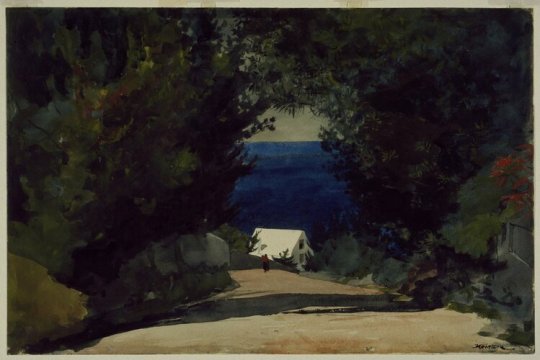
Road in Bermuda, Winslow Homer, ca. 1899-1901, Brooklyn Museum: American Art
Medium: Watercolor on paper
https://www.brooklynmuseum.org/opencollection/objects/104497
4 notes
·
View notes
Text
The Elizabeth Home for Girls
In honor of @newsies-girls-week, I have finally gotten around to making a post about the Children’s Aid Society’s girl’s lodging house- The Elizabeth Home for Girls.

The Elizabeth Home for Girls was opened on December 13th, 1892 (the image above was taken in 1895), and was located at No. 307 East Twelfth Street in Manhattan. As previously stated, it was owned and operated by the Children’s Aid Society (the same group who owned and ran the Duane Street Manhattan Newsboy’s Lodging House). It was the place where a young newsgirl or orphan without any other family likely would have stayed- girls did not stay in the same lodging house as the boys under any circumstances.
The home was built to replace the previous girl’s lodging house, which had been established in 1863 and was located at No. 21 or 27 St. Mark’s Place in Manhattan. It had four floors, each with a specific layout (which we’ll get into in a moment) and had about 58 beds in all.
The girl’s home was a bit different than the boy’s lodging house in that the girls who lived there were young adults as well as children and teenagers. The 1900 census lists the lodgers as being mostly between the ages of 14 and 21, in contrast to the boy’s lodging house which prohibited boys over the age of 18 from living there. The girl’s home was also intended to teach the girl’s specific trades, such as laundry, sewing, dressmaking, or typing. As such, the home had facilities for the girls to learn each of these skills.
The cellar of the home contained the trunk room, storage room, and the hot-water heater and water pump to supply hot and cold running water throughout the home. The basement (one floor above the cellar) contained two dining rooms, the kitchen, the lavatory, two bathrooms, the laundry room for the girl’s clothes, and a large room for ironing, washing, and drying “custom work” (the girls who lived in the home took in sewing and dressmaking orders as well as laundry orders to make money).
The first floor contained the classrooms for typing and sewing machine classes and a fitting room for dressmaking, as well as the home’s main office, a reading room, and a waiting/reception room. The second floor contained the matron’s room, a sitting room for the girls, two dormitories, and two bathrooms. The third floor contained five smaller bedrooms, one larger dormitory, a lavatory, a bathroom, and a workroom for dressmaking. And, finally, the fourth floor contained five dormitories, two smaller bedrooms, and three single rooms.
Not all of the girls who lived at the Elizabeth Home were newsgirls or match girls, although some very well could have been. Almost all of them were orphans or children who had been abandoned by their families, however, and many of them eventually left the city on orphan trains to go west and be adopted by farm families there.
The building itself was expanded in 1901 by the CAS when they bought and annexed the building next door, and in 1930 the CAS sold the home. However, unlike with the Duane Street Lodging House which was eventually demolished, the building in which the Elizabeth Home for Girls was once located is still standing today! The inside was gutted in the 1980s and I believe it’s just a private residence now, but it was named a landmark in 2008 and the outside of the building remains largely unchanged.

I hope everyone enjoyed this post, and that you learned something new form it! You may go forward now fully equipped to write about the girl’s lodging house in Manhattan in 1899, and if you would like to learn more about the boy’s lodging house in 1899 you can find the post I wrote about it here.
Sources:
http://nineduane.queenitsy.com/eliz.html
https://www.nytimes.com/2008/06/08/realestate/08scap.html
35 notes
·
View notes
Text
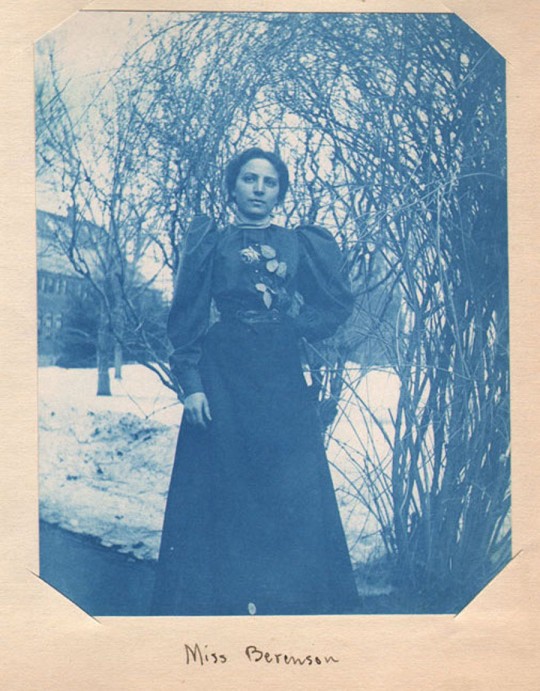
Unknown American photographer: cyanotype: ca. 1897-99. "Miss Berenson” (Senda Berenson Abbott: 1868-1954), known as the ‘’Mother of Women's Basketball'' Berenson was first hired as a gymnastics instructor at Smith College before becoming the Director of the Gymnasium and Instructor of Physical Culture there, adapting the first rules of women's basketball in 1892. The game had been invented less than a year earlier by James Naismith in nearby Springfield, Mass. By 1899, Berenson had codified her rules for the women’s game, and in 1901, they were published in the volume “Basket Ball for Women” by Spalding’s Athletic Library. From: PhotoSeed Archive via Photoseed Blog
View on WordPress
#basketball#cyanotype#full length portrait#portrait#Porträt#retrato#ritratto#portret#retrat#Bildnis#senda berenson abbot#unknown photographer
16 notes
·
View notes
Text
Animali

A snow storm, 1891 ca. | William Edward Stott (1855-1918, England)

Cavallo bianco (white horse), 1634-1638 | Diego Velázquez (1599-1660, España)

L’amazzone (Alice Regnault), 1878 (Galleria d'Arte Moderna, Milano) | Giovanni Boldini (1842-1931, Italia)

Le comte Alphonse de Toulouse-Lautrec, 1883 (Mead Art Museum at Amherst College, Amherst) | Henri de Toulouse-Lautrec (1864-1901, France)

Die katze (the cat), 1901 | Hans Thoma (1839-1924, Germany)

The races at Longchamp, 1866 (Art Institute Chicago) | Édouard Manet (1832-1883, France)

Course à obstacle; le jockey tombé (il fantino caduto), 1866 | Edgar Degas (1834-1917, France)

Pushkin in the village, 1899 | Valentin Serov (1865-1911, Russia)

Prospectus en russe pour la réouverture du cabaret Chat Noir, 1896 | Théophile Alexandre Steinlen (1859-1923, Switzerland)

Cocorico | Théophile Alexandre Steinlen (1859-1923, Switzerland)

Cortile in Banditella, 1895 ca. | Raffaello Gambogi (1874-1943, Italia)

Metzengerstein, 1884 - from Edgar Allan Poe's Tale | Hermann Vogel (1854-1921, Germany)
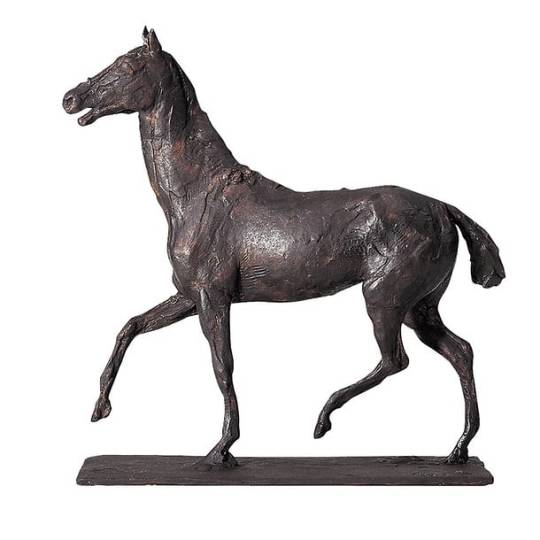
Cheval au pas | Edgar Degas (1834-1917, France)

Jokey | Henri de Toulouse-Lautrec (1864-1901, France)

La signorina Rita Tibolla, La signorina col cane (Lady with dog), 1904-05 | Giulio Ettore Erler (1876-1964, Italia)
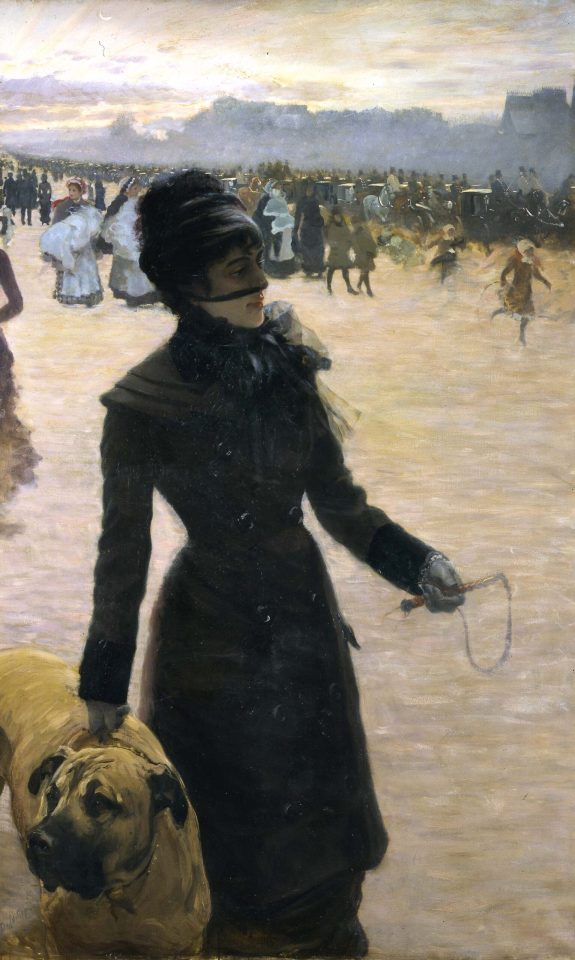
Signora con cane (Ritorno dalle corse) - Lady with dog (Return from racing), 1878 | Giuseppe De Nittis (1846-1884, Italia)

The Raven (Il Corvo), 1971 | David Inshaw (1943, England)

La Dama con l'ermellino, 1488-90 (Museo Czartoryski, Cracovia) | Leonardo da Vinci (1452-1519, Italia)
1 note
·
View note
Photo


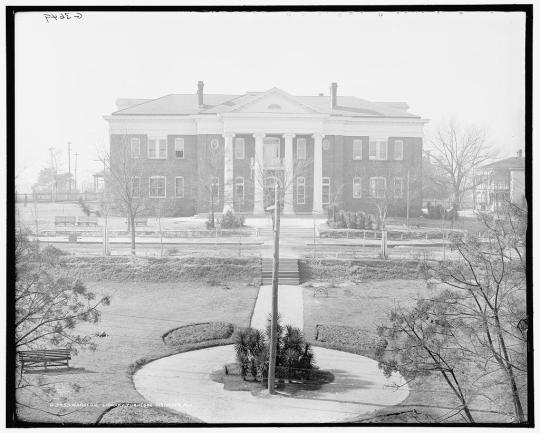


Robert Robinson Taylor (June 8, 1868 – December 13, 1942)
Robert Robinson Taylor was the first academically trained and credentialed black architect in America.
He grew up in North Carolina where he worked as a carpenter and foreman for his father, Henry Taylor, who was a former slave.
Taylor attended the Massachusetts Institute of Technology, becoming the school’s first black graduate. While a student, he met Booker T. Washington, who later recruited him to lead the industrial program and campus expansion of the Tuskegee Institute in Alabama. The institute is an African American vocational school that is now a designated National Historic Site.
Over the course of his career, Taylor designed more than 25 buildings on the Tuskegee campus, along with libraries, housing, museums, and other academic buildings across the United States.
He also laid out architectural plans and devised a program in industrial training for the Booker Washington Institute in Kakata, Liberia.
Science Hall was the first Tuskegee building designed by Taylor and completed in 1893, later renamed Thrasher Hall. Photo: Frances B. Johnson, Courtesy Library of Congress.
Huntington Hall at Tuskegee Institute, completed in 1899, shown ca. 1906. Source: Detroit Publishing Company, Library of Congress.
The Carnegie Library Building at Tuskegee Institute was designed by Robert R. Taylor and completed in 1901. Source: Detroit Publishing Company, Library of Congress.
Dorothy Hall was designed by Robert R. Taylor for Tuskegee Institute and completed in 1901. Source: Detroit Publishing Company, Library of Congress.
The Oaks, designed by Robert R. Taylor, was completed in 1899 and served as the president's house at Tuskegee Institute. Source: Detroit Publishing Company, Library of Congress.
#art#design#Architecture#history#robert R. taylor#equal rights#human rights#historic landmark#america#american history#black history month#black history facts#black history is american history#library of congress#dorothy hall#the oaks#sciencehall
90 notes
·
View notes
Text
Milano: "Leonardo Bistolfi, simbolista visionario", la nuova mostra di Galleria Silva
Milano: "Leonardo Bistolfi, simbolista visionario", la nuova mostra di Galleria Silva.
Dal 20 ottobre Galleria Silva accoglierà una scelta delle più affascinanti e visionarie opere di uno dei maggiori protagonisti del simbolismo europeo: Leonardo Bistolfi (Casale Monferrato, 15 marzo 1859 – La Loggia, 3 settembre 1933). La mostra sarà una ricognizione all'interno dell'affascinante e visionario universo espressivo dello scultore piemontese, il cui personalissimo e altamente immaginoso linguaggio plastico ebbe non poche ripercussioni stilistiche tanto in Europa quanto oltreoceano, arrivando a influenzare la coeva statuaria monumentale dell'America centromeridionale (infatti già all'epoca la critica parlava di "bistolfismo" e di scultori "bistolfiani").
Formatosi prima all'Accademia di Brera a Milano e poi all'Albertina di Torino, sotto la guida di Odoardo Tabacchi, dopo un esordio di matrice verista e scapigliata, Bistolfi aprì i propri orizzonti estetico-culturali al simbolismo letterario di matrice franco-fiamminga e alle istanze del decadentismo europeo. Egli si identificava in modo particolare nel concetto di "operaio della Bellezza", seguendo una linea ideologica e spirituale che era, in sostanza, quella tracciata da John Ruskin e William Morris.
Proprio al periodo simbolista, il più rappresentativo e influente della sua intensa carriera, è dedicata l'esposizione di Galleria Silva: un percorso ideale che va da una versione in gesso della testa dell'Alpe per il Monumento a Giovanni Segantini di Saint-Moritz (La Bellezza liberata dalla Materia, 1899-1906), forse la scultura più iconica dell'intera produzione bistolfiana, per approdare al marmo La Volontà o L'Industria (1925 ca.), uno straordinario esemplare proveniente dalla collezione storica di un illustre personaggio, legato a Bistolfi da un antico vincolo amicale, e da essa mai uscito fino a oggi. La Volontà rappresenta al massimo grado la parziale mutazione dei moduli simbolisti dell'autore, avvenuta dopo la Grande Guerra e durante i primi anni del ventennio littorio, per cui il turgore delle forme e la monumentalità della figura allegorica tradiscono un timbro diverso, più carico e sensuoso, in un certo senso più "novecentista", rivelando una sontuosità e un'opulenza visibilmente accentuate.
Completano il percorso un esemplare di misure ridotte della Croce Brayda (1901), assai rara da trovarsi in terracotta; la targa per la Società Bibliografica di Torino (1905-1906), prezioso gesso carico di echi preraffaelliti, dedicato all'amico scultore, pittore e scenografo Lodovico Pogliaghi; il particolare in bronzo della figura femminile di destra della targa per la Cassa di Risparmio di Milano (1906), uno dei testi figurativi di Bistolfi maggiormente compromessi con il Liberty, sull'onda lunga dell'Esposizione internazionale d'arte decorativa moderna di Torino del 1902, per la quale l'artista aveva disegnato un celebre manifesto; l'ispiratissima targa funeraria per André Gladès (1906-1908 ca.), pseudonimo maschile della scrittrice svizzera Nancy-Marie Vuille, morta trentanovenne a Ginevra nel gennaio 1906; il bassorilievo in gesso della Culla per il monumento-ossario La Patria (1906), commemorativo della battaglia del 1706 a Madonna di Campagna; il gesso del verso del modello della medaglia per le gare sportive "Florio" di Palermo (1907); e, sempre in gesso, la testa della figura della Morte del monumento funerario Abegg (1912-1913), collocato nel cimitero di Zurigo. Non va infine dimenticata la targa in bronzo per Giovanni Faldella e Leonardo Bistolfi (1913), cavalieri dell'ordine civile di Savoia, significativa opera "bistolfiana" del torinese Edoardo Rubino.
In mostra sarà presente un catalogo a cura di Armando Audoli....
#notizie #news #breakingnews #cronaca #politica #eventi #sport #moda
Read the full article
0 notes
Text
Some of My Updated Art History Tags

Primavera, 1482, by Sandro Botticelli (c. 1445-1510).
ARTISTS l MOVEMENTS l TECHNIQUES l TIMELINE
Time periods:
Here is everything - artists, techniques, movements, and artwork - together, organised by time periods:
Ancient Art
Medieval Art (ca. 400- 500)
Renaissance Art (ca. 1300-1600);
The Renaissance: The Early Renaissance (c.1400s-)
13th Century; 1200s l 14th Century; 1300s
15th Century; 1400s l 16th Century; 1500s
17th Century; 1600s l 18th Century; 1700s
19th Century; 1800s l 20th Century; 1900s
Contemporary Art
Forms of media:
Sculpture & Painting l Collage l Performance Art
Design l Fashion l Embroidery
Poetry l Quotes l Videos
Artists:
Female Artists l Famous Artists
A list of artists in alphabetical order (of last name):
A
Anguissola, Lucia (c. 1536-c. 1565); female Italian Renaissance artist
Anguissola, Sofonisba (c. 1535-1625); female Italian Renaissance artist
Anquetin, Louis (1861-1924); cloisonnism
B
Bailey, Amadea; female contemporary expressionist artist
Barboza, Ana Teresa (1980- ); contemporary art; embroidery
Beksiński, Zdzisław (1929-2005); dark surrealism
Booth, Anastasia; contemporary sculpture/installation/photography artist
C
Cabanel, Alexandre (1823-1889); french academic artist
Carlson, Larry; digital contemporary artist
D
Darger, Henry (1892-1973); an outsider artist
E
Ekster, Aleksandra (1882-1949); abstract designer
F
Fontana, Lavinia (1552-1614); female Italian Renaissance painter
G
Galizia, Fede (c. 1578-c. 1630); female Italian Renaissance painter
Gogh, Vincent van (1853-1890); dutch artist; post-impressionist (also, The Death of Vincent van Gogh)
Goodsir, Agnes (1864-1939); australian-born artist known in France
H
Hemessen, Catharina van (1528-c. 1565); female Flemish Renaissance artist
K
Kahlo, Frida (1907-1954); modern female artist; surrealism
Kandinsky, Wassily (1866–1944); russian abstract painter
Klimt, Gustav (1862-1918); austrian artist
Kondakov, Alexey; contemporary collage artist
L
Lempicka, Tamara de (1898-1980); female art deco painter
Lewis, Edmonia (c. 1844-1907); African-American/Native American female sculptor
Longhi, Barbara (1552-1638); female Italian Renaissance artist
Lundeberg, Helen (1908–1999); surrealist
M
Makart, Hans (1840-1884); was Austria’s most sought-after artist during his time
Monet, Claude (1820-1926); impressionist
Mucha, Alphonse (1860-1939); czech illustrator
Moser, Mary (1744-1819); English academic artist known for her flower works
N
Nelli, Plautilla (1524-1588); self-taught artist nun during the Renaissance in Florence
R
Rockwell, Norman (1894-1978); American illustrator
Rodin, Auguste (1840-1917); famous French sculptor
S
Sandys, Emma (1843-1877); female pre-raphaelite artist
Savage, Augusta (1892–1962); famous female artist during the Harlem Renaissance
Serov, Valentin (1865-1911); impressionist
Shōen, Uemura (1875-1949); female Japanese artist
Siddal, Elizabeth (1829-1862); female Pre-Raphaelite muse, artist, and poet
Sterrett, Virginia Frances (1900-1931); american illustrator
Stokes, Marianne (1855-1927); victorian female artist
T
Taeuber-Arp, Sophie (1889-1943); known for abstract textile art
Tiffany, Louis Comfort (1848-1933); stained glass artisan
Tissot, James (1836–1902); french artist
Turner, J. M. W. (c. 1775-1851); romanticist landscape artist
U
Utamaro, Kitagawa (c. 1753-1806); japanese ukiyo-e woodblock artist
W
Wolfli, Adolf (1864-1930);outsider artist
Y
Yuliang, Pan (1899-1977); first woman to paint in western style in China
Z
Zorach, Marguerite (1887-1968); fauvist painter
I also have tags sorted by nationality of art/artist (although it needs some work). If you are interested in exploring it, it’s on this page.
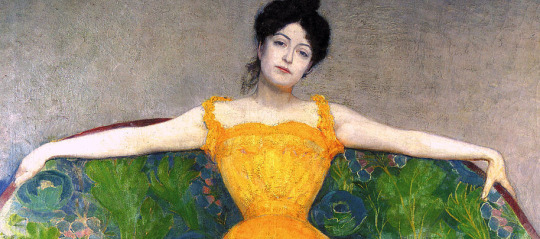
Woman in a Yellow Dress, 1907, by Max Kurzweil (1867-1916).
Other Stuff You Might Enjoy:
Recommended Art Books
Information Tag
Exhibition History:
Hitler and Degenerate Art
Artist History:
William Morris’ Part in Arsenic Houses
The Death of Vincent van Gogh
The Last Painting of Frida Kahlo
Painting History & Painting Analysis:
The Sick Child, by Edvard Munch
The Lady with the Veil, by Alexander Roslin (One of my favourite paintings)
Analysis of the painting Salomé, 1909, by Paul Antoine de la Boulaye
The History Behind La Mort de Barbara Radziwiłł, 1841, by Józef Simmler
In Bed, The Kiss, 1892, by Henri Toulouse-Lautrec (1864-1901)
The History Behind Gustav Klimt’s ‘The Woman in Gold’
Sculpture History & Sculpture Analysis:
Venus of the Beautiful Buttocks
Sculpture of Pietà
Who’s in Antonio Canova's The Three Graces?
My followers’ art; if you’re an artist, or just enjoy drawing/painting/etc, I’d love to see your art!
#list#art#art history#art history blog#painting#sculpture#artwork#fine art#contemporary art#renaissance#tags#artists#artist#paintings#famous art
1K notes
·
View notes
Photo

My little planet, Galust Mkhitaryan
I created a "world list". Even many famous and good people did not get into this work, but they are much more on the list, I'll draw the next time. In the picture all the colors, all the styles in the painting. 252 people, 252 masterpieces, portraits. in this picture are depicted 252 influential people of our planet. People who created our world. The painting is a real museum exhibit, where he painted 252 masterpieces. The very first king from the Mesopotamia, known science Alilum a2 - Lu-Lim XXX BC famous Gilgamesh XXVII-XXVI and the first pharaoh of the first dynasty of Egypt Menes. in my list found the places Iisus Hristos, Muhammad, In the list I painted portraits of great scientists and artists. Great artists and athletes. My heroes, from all over the world and states. There are heroes from China, America, from Central America, from Europe, from Russia. from Armenia and from the East. Successful businessmen of all time, the famous Morgan, Rockefeller and today's Mark Zucemberg. In the picture I drew and negative people in the negative form is Hitler, this is Stalin is Lenin and others. Features of the picture. Thanks to my work, many ancient heroes found their faces. Based on ancient sketches, sculptures and bas-reliefs, I created their faces. Now, Kleopatra,. Tutankhamen, Gilgamesh, Hammurabi have their scientific faces. I was inspired to this work by a portrait of SirWinston Churchill and Charlie Chaplin. After I thought of drawing all the influential people. In the picture, I decided to use different styles, and genres for a change. I also want to show the world to the whole world that the 1915 scum of the Turks cut out such a talented people as the Armenians, and I drew representatives of the Armenian people such as Aram Khacaturyan Charles Aznavour Michel Legrand and many Armenian origins. This is my list of the World, I believe that it is necessary to create such a picture list and make people happy, so that everyone can see on one canvas at once. In the future I will draw even more people, many modern people who did not get into the picture let me be forgiven, because this was the first work. and was very difficult. I think that the picture will be very interesting and attractive. People will walk with phones, turn on the Internet and look for those who are pictured in the picture. At the opening of the exhibition, there will be a queue for viewing portraits. This picture I spent 7 months enjoying the viewers, I dream that people learn from newspapers and from the Internet go and look at this work, in any city where I go to show, there will be numerous views. I specifically tried to draw different styles and techniques. I documented the video snapshots sent by representatives of Guinness World Records. I hope that a positive response will come and I will set a record., The real value of the picture is 1 million Euro. I in other sites exhibited a picture for a million dollars. In Saatchi there is a limit of 100 thousand dollars, so I put out 100 thousand. If in the Saatchi Site the first person who buys something I will sell for 100 thousand dollars. .List of people 1.Gautama Budda Born c. 563 BCE or c. 480 BCE Died c. 483 BCE or c. 400 BCE 2.Maria Mother of Jesus Third quarter of de icentury BC. The middle of the 1st century 3.Iisus Hristos 4 î.Hr. 33 d.Hr. 4. Muhammad April 26, 570 January 8, 632 5 Hayk XXXII or XXX centuries BC. E. 6.Piotr Weliki 30may 1672 28 January 1725 7.Elizabeth I. 7 September 1533 24march 1603 8.Alexandr Graham Bel 3 march 2 August 1922 9.Charlies Robert Darvin 12 February 1809 19 April 1882 10.Enrico Fermi 29 September 1901 - 28 November 1954 11.Tomas Woodrow Wilson 28 Dekember 1856 3 February 1924 12.Winston Churchill Sir 30 November 1874 24 January 1965 13.John F. Kennedy 29 May 1917 - 22 November 1963 14.Charles de Goulle 22 November 1890 9 November 1970 15.William Henri Gates 28 Oktober 1955 16.Minas Avetisyan 20 July 1928 24 February 1975 17.Galust Gulbenkian 23 March 1869 20 Juli 1956 18.Arshille Gorki 15 April 21 July 1948 19.Grigor Shldyan 20 August 1900 1 April 1985 20.Jean Jansem 9 March 1920 27 August 2013 21.Vuslim Magomayev 17 August 1942 25 oktober 2008 22.Demis Roussos 15 1946 25 January 2015 23. Goyko Mitich 13 Junen1940 24.Stiven Frederic Segal 10 April 1952 25. Jean-Claude Van Damme 18 October 1960 26. Alilum a2 - Lu-Lim XXX BC 27. Gilgamesh XXVII-XXVI 28.Menes 2800 BC 2700 BC 29. Kleopatra 2 November 69 12 August 30 BC 30. Nefertiti 1370 BC 1330 BC 31. Tutankhamen XVIII Dynasty of the Nev Kingdom 1332-1323 32. George Washington 22 Febrary 1732 14 December 1799 33. Hammurapi 1820 1750 BC 34. Johann Sebastian Bach 21-31 March 28 July 1750 35. Merritt Singer 27 October 1811 23 July 1875 36. Alfred Bernhard Nobel 21 October 1833 10 December 1896 37. Amerigo Vespucci 9 March 1454 22 February 1512 38. Coco Chanel 19 Augusta 1883 10 January 1971 39. Gianni Versace 2 Dekember 1948 15 July 1997 40. Stive Jobs 24 February 1955 5 October 2011 41. John Davison Rocefeller 8 July 1839 23 May 1937 42. Sr John Pierpont Morgan 17 April 31 March 1913 43. Raymond Alfred «Ray» Kroc 5 October 1902 14 January 1984 44. Andrew Carnegie 25 November 11 August 1919 45. Walter Elias Disney 5 December 1901 15 December 1966 46. Martiros Saryan 28 February 1880 5 May 1972 47. Ciorgio Armani 11 July 1930 48. Jack" Kevorkian 26 May 1928 3 June 1911 49.Garegin Nzhdeh 1 January 1886 21 December 1955 50. Arthur Abraham 20 February 1980 51. Sergei Parajanov 9 January 1924 20 July 1990 52. Tigran Petrosyan 17 June 1929 13 August 1984 53. Alessandro Safina October 14, 1963 54. Antonio Banderas 10 August 1960 55. Mark Elliot Zucemberg 14 May 1984 56. Sir Isaac Newton 25 December 1640 20 March 1726 57. Will Smith 29 September 1968 58. Leonardo Di Caprio 11 November 1974 59. Alla Pugachova 15 April 1949 60. Gyros 590 BC 530 BC 61. Flavius Valerius Aurelius Constantinus 27 Febrary 272 23 May 337 62. Asoka 304 BCE 232 BCE 63. Gaius Julius Cesar 13 July 100 BC 15 March 44 BC 64. Aleksandr Makedonski 356 July 323 BC 65. Genghis Khan 1156 - 1162 25 August 1227 66. Ferdinand Porsche 3 September 1875 January 1950 67. Emest Hemingway 21 Jule 1899 2 Jule 1961 68. Nikolaus Copernicus 19 Feruary 1473 14 May 1543 69. Michelangelo 6 March 1475 18 February 1564 70. Galileo Galilei 15 Feruary 1564 8 January 1642 71. Boris Piotrovski 14 February 1908 15 Oktober 1990 72. Henry Ford 30 July 1863 7 April 1947 73. Baron Amchel Mayer von Rotscchild 23 Febrary 1744 19 September 1812 74. Cornelius Vanderbilt 27 May 1794 4 January 1877 75. Alexander Vasilyevich Suvorov 24 November 1730 18 May 1800 .76. Vasco da Gamma 29 September 1469 24 December 1524 77. Mikhail Gorbachov 2 March 1931 78. Abraham Alikhanian 20 February 1904 8 December 1970 79. Shavarsh Karapetyan 19 May 1953 80. Andre Aggasi 29 April 1970 81. Komitas 26 September 1869 22 Oktober 1935 82. Yurik Vardanyan 13 June 1956 83. Cher Cherlyn Sarkisyan 20 May 1946 84. George Clooney 6 May 1961 85. Jackie Chan 7 April 1954 86. Jean-Paul Belmondo 9April 1933 87. Alain Delon 8 november 1935 88. Elton Jhon March 1947 89. Elvis Presley 8 January 1935 90. Cai Lun 48-62 CE 121 91. Aristotel 384 BC - 322 BC 92. Emperor Wen ot Han 202 BC 157 BC 93. Sui Wendi 21 July 541 AD 13 August 604 94. Erik Raudi Thorvaldsson 950 103 95. Leonardo Da Sir Piero da 15 April 1452 2 May 1519 96. Willam Shakespeare 1564 23 April 1616 97. Ludwig Van Beethoven December 1770 26 March 1827 98. Alexander Dumas 24 July 1802 5 December 1876 99. Mikhail Lomonosov 19 November 1711 15 April 1765 100. Fridtjof Nansen 10 October 1862 30 May 1930 101. Nelson Rolihlahla Mandela 18 July 1918 5 December 2013 102. Mother Tereza 26 August 1910 5 September 1997 103. Indira Gandhi 19 November 1917 31 October 1984 104. Karl Marx 5 May 1918 14 March 1883 105.Viktor Amazaspovich Ambartsumyan 18 September 1908 12 August 1996 106. Ovanes Aivazovski 17 Juny 1817 2 May 1900 107. Arno Babajanyan 22 January 1921 11 November 1983 108. Aram Khacaturyan 6 June 1903 1 May 1978 109. Andranik Zoravar Ozanyan 25 Feebruary 1865 31 August 1927 110. Kirk Douglas 9 December 1916 111. John Winston Lennon 9 October 1940 8 December 1980 112. Louis Daniel Armstrong 4 August 1901 6 July 1971 113. Charlie Chaplin 16 April 1889 25 Dekember 1977 114. Louis de Funes 31 July 1914 27 January 1983 115. Bruce Lee 27 November 1940 20 July 1973 116. Lise Koch 22 September 1906 1 September 1967 117. Lavrenti Pavlovich Beria 29 March 1899 23 Dekember 1953 118. Heinrich Luitpold Himmler 7 October 1900 23 May 1945 119. Lenin 22 April 1870 21 January 1924 120. Adolf Hitler 20 April 1889 30 April 1945 121. Tamerlane 9 April 1336 19 February 1405 122. Spartacus Diet in April 71 BC 123. Hipokrat 1 March 460 CE 370 CE 124. Niccolo Paganini 27 October 1782 27 May 1840 125. Robertino Lorreti 22 October 1946 126. Wolfgang Amadeus Mazart 27 January 1756 5 December 1791 127. Cristopher Columbu 31 October 1451 20 May 1506 128. Albert Einstein 14 March 1879 18 April 1955 129. Andrei Dmitrievich Shakarov 21 May 1921 14 December 1989 130. Ferdinand Magellan 3Februari 1480 27 April 1521 131. James Gamble 3 April 1803 29 April 1891 132. Isbella I de Castille 22 April 1451 26 November 1504 133. Che Guevara 14 June 1928 9 October 1967 134. Micho SUzuki 10 February 1877 27 october 1982 136. Dalai Lama 6 July 1935 137. Mesrop Mashtoch 361 17 February 441 138. Ovanes Bagramyan 2 Dekember 1897 21 September 1982 139. Gevorg Vardanyan 17 February 1924 10 January 2012 140. Hovhannes Toumanyan 19 February 1869 23 March 1923 141Movses Khorenatsi 410 CA 490 142. Raj Kapoor 14 Dekember 1924 2 June 1988 143. Fatima Rashid Nargis Dutt 1 June 1929 3 May 1981 144. Paul Mc Cartney 18 June 1942 145. Alexander Sergeyevich Pushkin 6 June 1799 10 February 1837 146. Garsia Lorca 5 June 1898 19 August 1936 147. Tigranes II 95 CE 55 CE 148. Josep Stalin 18 December 1878 5 March 1953 149. Pol Pot 19 May 1925 15 April 1996 150. Enver Pasha 22 November 1881 4 August 1922 151. Mehmed Talat pasha 10 April 1874 15 March 1921 152. Delphine La Laurie 19 March 1787 7 December 1849 153. Herostratus Diedc 356 BC 154. Amin Idi Dada 1923 16 August 2003 155. Shiro Ishii 25 June 1892 9 October 1959 156. Stiven Allan Spielberg 18 Dekember 1946 157. Julio Iglesias 23 September 1943 158. Monserrat Caballe 12 April 1933 159. John Christopher Depp 9 June 1963 160. Mark Tvain 30 November 1835 21 april 1910 161. Confucus 09 -28 551BC 479 162. Napoleon Bonapart 15 August 1769 5 May 182 163. Mansur Hasan Firdousi Tusi 935 1020 164. Nizami 1141 1209 165. Omar Khayyam 18 May 1040 4 december 1131 166. Quanah Parker 1845- 1852 25 Feburary 1911 167. Robert Bosh 23 September 1861 12 March 1942 168. Jams Clerk Maxvell 13 June 1831 5 Novwmber 1879 169. Martin Luther King 15 January 1929 4 April 1968 170. Lev Nikolaevich Tolstoy 9 September 1828 20 November 1910 171. Armen Dzhigarkhanyan 3 October 1935 172. Charles Aznavour 22 May 1924 173. Jivan Gasparyan 12 October 1928 174. Yousuf Karsh 23 December 1908 13 June 2002 175. Kim Kardashian 21 October 1980 176. Serj Tankian 21 August 1967 177. Luciano Pavarotti 12 October 1935 6 September 2007 178. Viktoria Ronjina 7 December 2011 179. Arnold Schawarzenegger 30 July 1947 180. Mel Gipson 3 January 1956 181. Sylvester Stollone 6 July 1946 182. Amitabh Bachchan 11 October 1942 183. Adriano Celentano 6 January 1938 184. Bridgitte Dordot 28 September 1934 185. Sophia Loren 20 September 1934 186. Sara Brightman 14 August 1960 187. Elizabeth Taylor 27 February 1932 23 March 2011 188. Jean Alfred Villain-Mararis 11 December 1913 8 November 1998 189. Janne d. Arc 6January 1412 30 May 1431 190. Arhimed 287 BC 191. Paul The Apostle 5-10 67 192. Jacques-Yves Cousteau 11 June 1910 25 June 1997 193. Yuri Gagarin 9March 1934 27 March 1968 194. Julius Robert Oppenheimer 22 April 1904 18 February 1967 195. Mikhail Kalashnikov 10 November 1919 23 December 2013 196. Dmitri Ivanovich Mendeleev 8 February 1834 2 February 1907 197. Simon Bolivar 24 July 1783 23 December 1830 198. Salvador Dali 11 May 1904 23 January 1989 199. Wassily Kandinsky 16 Dekember 1866 13 Dekember 1944 200. Andy Warhol 1 August 1928 22 February 1987 201. Michel Jean Legrand 24 February 1932 202. William Saroyan 31 Augusta 1908 18 May 1981 203. Artem Ivanovich Mikoyan 5 August 1905 9 December 1970 204. Larry Gagosyan 19 April 1945 205. Jean Carzou 1 January 1907 17 November 2000 206. Vasily Alekseyev 7 January 1942 25 November 2011 207. Angelina Jolie 4 June 1975 208. Aishwarya Rai 1 November 1973 209. William Bradley Pitt 18 December 1963 210. Jennifer Lynn Lopez 24. July 1969 211. Dahram Singh Deol Dharment dra 8 December 1935 212. Hema Malinini R Chakravarth c 16 Oktober 1948 213. Jordi Cruyff 25 April 1947 24 March 2016 214. Eusebio da Silva Ferrera 25 January 1942 215. Herd Muller 3 November 1945 216. Pele 21 October 1940 217.Sergei Pavlovich Korolev 12 January 1906 14 January 1966 218. Muhammad Ali 17 January 1942 3 June 2016 219. Ronaldinho Gaucho 21 March 1980 220. Adrey Shevchenko 29 September 1976 221. Pablo Picasso 25 October 1881 8April 1973 222. Paul Gauguin 7 June 1848 8 May 1903 223. Vincent Van Gogh 30 March 1853 29 July 1890 224. Zurab Tsereteli 4 January 1934 225. Ayrton Senna 21 March 1960 1 May 1994 226. John Tavares 20 September 1990 227. Lev Ivanovich Yashin 22 October 1929 20 March 1990 228. Wladimir Klitschko 25 March 1976 229. Vitali Klitschko 19 July 1971 230. Carlos Ray Chak Norris 10 March 1940 231. Alfredo James Pacino 25 April 1940 232. Michael Joseph Jackson 29 August 1958 25 June 2009 233. Marilyan Monroe 1June 1926 5 August 1962 234. Diego Armando Maradona 30 October 1960 235.Ronaldo Luis Nazario de Lama 18 September 1976 236. Lionel Andres Messi 24 June 1987 237. Cristiano Ronaldo 5 February 1985 238. Oleh Blokhin 5 November 1952 239. Michel Francois Platini 21 June 1955 240. Alex Ferguson 31 December 1941 241. Steffi Graf 14 June 1969 242. Franz Anton Beckenbauer 11 September 1945 243. Carl Lewis 1 June 1961 244. Irina Rodnina 12 September 1949 245. Michael Jeffrey Jordan 17 February 1963 246. Ezekiel Kemboi Cheboi 25 May 1982 247. Serhii Nazarovych Bubka 4 December 1963 248. Shaguille Rashaun O' Nea 6 March 1972 249. Valeri Kharlamov 14 January 1948 27 August 1981 250. Michael Schumacher 3 January 1969 251. Mike Tyson 30 June 1966 252. Mkhitaryan Galust 1 January 1959
https://www.saatchiart.com/art/Painting-My-little-planet/906390/4318854/view
3 notes
·
View notes